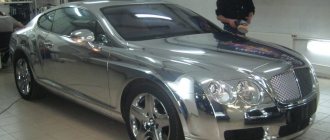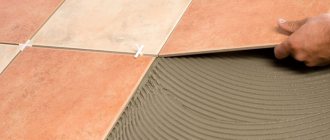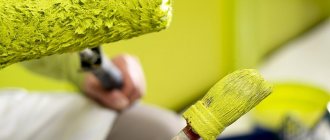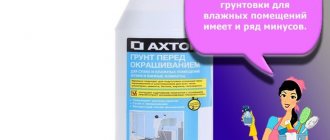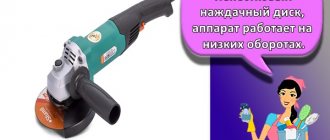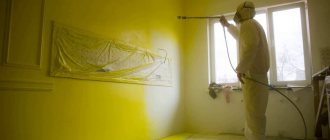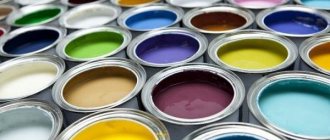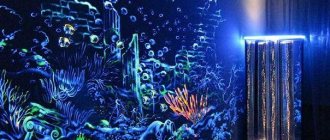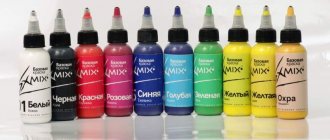Paints and varnishes are on sale in a wide variety, and choosing a product that will help you get a high-quality and long-term result is becoming more and more difficult. For this reason, you should know the characteristics of different types. Latex water-based paint is in demand due to its positive properties. What is the difference from other paintwork materials and how to use it correctly will be discussed below.
What it is
Latex paint is a solution that consists of enamel made on a water-dispersed base. Its main component is natural latex, which provides a high level of protection from various types of exposure. This component by its nature is the juice of rubber plants.
If you use this element to make paints, then the cost of such material will be too high. To make it more accessible, it was decided to use synthetic polymers, which have an affordable price.
Despite the fact that latex paints are characterized by a liquid state that contains water, this does not allow the polymer particles to dissolve and stick together. After applying this solution to the surface, the liquid simply evaporates for some time. As for the polymer particles, they gradually begin to approach each other, and eventually stick together. After the water has completely evaporated, the surface dries and is covered with a continuous film, the adhesion to the surface of which is quite strong.
Benefits of use
Like any building material that is used for home renovation, latex paints have a number of positive characteristics, thanks to which they are in demand among a wide range of consumers.
Let's highlight the main advantages of latex paints:
- Any surface can be finished with latex paint. The solution fits perfectly on the walls, regardless of the method of its application.
- After painting, the coating is of high quality and durable, unlike the results of other paints.
- High level of environmental friendliness. Since the mixture contains no harmful components, the use of such material is absolutely safe . Such paints can also be used for rooms with high design requirements.
- You can create your own individual shade yourself. This is justified by the fact that the paint itself is white, and different colors are used to change the color.
- Economical. Since only 0.1-0.5 liters of solution are required per 1 m², this consumption is quite small. This indicator may vary slightly, it all depends on the quality of the surface being processed.
- Democratic pricing policy. Unlike the cost of oil-based enamel, latex paints are cheaper.
- High level of vapor permeability. Thanks to this property, the formation of condensation under the coating is excluded.
- After painting, a durable and resistant coating is obtained.
- The drying period of the paint is relatively short.
- Simplicity and ease of care. In case of contamination, the surface can be cleaned with a damp cloth.
Paint selection
To choose the ideal latex paint for ceiling decoration, you need to decide not only on its shade. An important parameter is the degree of gloss, which is divided into 6 categories. The lower the gloss number, the more matte the surface will be after drying.
A composition that provides an almost mirror-like finish is extremely rarely chosen, especially for walls. The most popular is considered to be a moderately matte paint.
It is also necessary to take into account parameters such as moisture and wear resistance. You can judge them using the abrasion cycle indicator, which is indicated on each package. The higher the number, the more durable the finish will be. Sometimes this characteristic is indicated in classes, the highest quality of which is the first class.
Flaws
Despite the large number of positive characteristics of latex paint, there are also negative aspects:
- Before you start painting, the surface needs to be leveled and all defects eliminated. This is necessary because this material is not able to hide even the slightest defects in the wall. Thus, the surfaces must be perfectly flat;
- Low temperatures and sudden changes can cause damage to the integrity of the coating. The presence of drafts and a decrease in the level of the thermometer leads to cracking of the painted layer. To return the original appearance of the surface, you need to redo all the work;
- Latex paints are water-based and harmless to everyone around them. This applies not only to people, but also to various bacteria. Thus, if the painted surface has not previously been treated with a special impregnation or primer, then there is a high probability of microorganisms, including those hazardous to health, developing on it.
Varieties
Latex paint is a finishing material that is used as the final stage of surface finishing. The quality of the resulting coating directly depends on the size of the fractions that are used in the solution.
Taking this indicator as a basis, latex paints are divided into matte, semi-matte and glossy categories. When making a choice in favor of a specific type, it is necessary to take into account its individual characteristics, as well as the characteristics of the room where the painting work will be carried out.
The use of matte paint makes it possible to visually change the space, namely, reduce it, hide small irregularities in the wall . Also, the distinctive characteristics of this type include resistance to regular cleaning and difficulty in maintenance, since it gets dirty easily and is difficult to wash.
To visually enlarge a room, glossy paint comes to the rescue. It gets even less dirty than the previous type, but it tends to wear off when washed. To achieve a positive effect from painting walls with a glossy solution, you need to carefully prepare the surface, namely level it, eliminating all unevenness and flaws.
Semi-matte paint has average characteristics. It combines the properties described above.
Types and applications
Washable latex water-based paint comes in different varieties, as mentioned earlier, different fillers are used, they give different capabilities to the coating. In order to choose the right type for a particular situation, you need to understand the varieties available on the market. The following types of material are distinguished:
- Facade type, used when it is necessary to cover the walls of a building from the outside;
- For work inside a building;
- There are specialized products for flooring; they are more wear-resistant and can withstand heavy loads for a long time;
- Compositions suitable for waterproofing work on various structures;
- Universal types that can be used both for the facade and for indoor surfaces, for example, for the bathroom.
Products may differ in the effect they achieve as a result of coloring. There are matte, semi-matte, glossy options; this variety makes it possible to choose the right option for any design.
The paint and varnish material also differs in its constituent components; the difference lies in the characteristics of the coating. Popular options will be discussed below.
In order to choose the right type for a particular situation, you need to understand the varieties available on the market.
Rubber acrylate-latex paint
This type was invented not so long ago, but it has already gained popularity due to its particular strength and resistance to environmental factors. Experts choose it for treating the surface of facades, sidewalks, swimming pools, and other surfaces that are constantly exposed to negative conditions. The product is diluted to obtain the desired consistency with water; special quality properties were obtained through the correct ratio of elements in the composition. The following advantages of rubber acrylate-latex paint are highlighted:
- Resistance to low-temperature and high-temperature influences;
- Quick-drying property allows you to quickly complete repair work;
- Universal, can be used on any type of substrate;
- Elastic property that prevents cracking of the layer during operation;
- Can be applied easily, using brushes, rollers, or spray guns;
- Durability of the result.
Can be used on any type of substrate.
Styrene Butadiene Latex Paint
This type is distinguished by its moisture-repellent property. The product is water-dispersible, therefore harmless, and can be used for interior finishing of various surfaces. Despite its water resistance, it is not a suitable option for outdoor use due to the lack of UV resistance, the color will lose its brightness too quickly, ruining the appearance of the layer.
Waterproof property is necessary in different rooms, even if there is no high humidity, because such coatings can be washed, so it is convenient to use them, for example, in the corridor, where wall contamination is common.
This type is distinguished by its moisture-repellent property.
Stages of work
Painting a surface with latex paints is a process that is almost no different from painting with other solutions.
The following stages of work are distinguished:
- The surface needs major cleaning. All remnants of the old coating must be removed, and if significant defects form, they will need to be eliminated.
Depending on the expected result, the paint can be applied in several layers. The time between approaches depends on the drying time of the treated surface.
In case of paint contamination, it can be removed using either a solvent or a soap solution in the shortest possible time.
Applying this solution to the surface is not a very complicated process; you can handle it yourself . To achieve a positive result, experts strongly recommend adhering to the established sequence.
A roller, a brush, or a spray bottle is perfect as an assistant for this type of work. There is no big difference depending on the type of tool used. The only compelling argument for choice is the ease of working with it. It should also be remembered that the entire surface should be painted in one approach. Otherwise, there may be unevenness along the border of areas that dry out.
Thus, latex paint is a universal finishing material, which is characterized by a wide range of uses, namely for coating walls, ceilings and other surfaces. This mixture will also cope well with the processing of concrete, plaster, brick, wallpaper, drywall, etc. Due to its individual characteristics, this solution is excellent for treating both new coatings and those that have been previously painted.
Features of surface preparation
It will be standard for all water-based compositions. It is necessary to clean the peeling plaster. A spatula is suitable for this. This also applies to plaster affected by fungus. There will be less dust if you wet the ceiling twice with a sprayer or roller. In this case, several hours should pass between wettings.
If the ceiling is affected by fungus or is located in a damp room, it must be treated with a primer with an antiseptic. Once dry, you can use any penetrating primer. It is better to apply it with a brush so that the composition penetrates into all the potholes.
Then you need to putty all existing defects. The best option is acrylic putty. A wide spatula is preferred as a tool. It will be easier for a person who does not have sufficient experience to achieve a perfectly flat surface.
Irregularities can be sanded using a special machine. But you can also use the manual method. Then the primer is applied again. After it dries, the surface will be completely ready for finishing.
Which latex paint for the facade to choose
This question needs to be asked before making a purchase. In this case, you need to choose the option for outdoor work. There are paints based on acrylic and styrene-butadiene latex. They are a water-dispersed emulsion of resin and fillers. Compositions based on acrylic latex are called acrylic.
Almost all building structures can be coated with latex mixtures, with the exception of metals due to their susceptibility to corrosion. Acrylic paints are considered more water-resistant. For surfaces made of different materials, additives are used to ensure compatibility between the coating and the substrate.
Technical characteristics of latex paints:
- service life more than 7 years;
- Drying time of the first layer is 1-4 hours, depending on the weather and humidity;
- final drying of the painted surface – 24 hours;
- water absorption W=0.03;
- density 1.3-1.42 kg/l;
- application temperature – from -20 to +30 0 C;
- permissible operation of the coating - from - 50 to +70 0 C;
- the coating can be matte, glossy, silky-glossy.
When choosing the color scheme of the facade, you need to take into account that in regions with a hot climate you need to use light colors. Such walls will not overheat and will keep the color fresh longer. For northern regions, bright, rich shades are more suitable.
On wood
For wooden surfaces, acrylic paint has good breathability; it does not clog the pores of the wood, allowing it to “breathe,” which increases the service life of the material. However, the acrylic composition does not destroy microorganisms, so special treatment is carried out first.
Latex emulsion coating preserves the grain of natural wood, which is especially noticeable when using white paint. By adding a certain color to the mixture, you can paint the house in different colors.
On concrete
Latex water-repellent paints are used for concrete facades. This coating protects walls from moisture, ultraviolet radiation, and does not crack as a result of temperature changes. In this case, compositions for mineral surfaces are used.
Brick by brick
For brick walls, latex mixtures are chosen, which form a film on the coating that hides such a nuisance as “efflorescence.” They adhere well to the brick surface, which makes them indelible. At the same time, they do not interact with salts and alkalis, leaving the surface uniform and neat.
What paint to use for certain surfaces
Water-based paints are distinguished by their high adhesion to most building materials - concrete, cement plaster, brick, wood. It is also possible to apply this paint to metal.
Brick
All materials based on water dispersions show good adhesion to brick. Preferred paints are acrylic or styrene-acrylic binders.
Concrete
Concrete is often used to make structures in contact with the soil. For their finishing, materials that form a waterproofing layer are preferred. Acrylic-silicone and rubber-acrylate materials satisfy this criterion better than others.
Acrylic silicone paints are ideal for painting concrete facades.
Tree
Paintwork materials based on styrene-acrylate dispersion fit well on wooden surfaces, emphasizing the texture of the wood.
Review of latex-based paint manufacturers and their prices
Among the manufacturers of latex facade paints, the most popular in Russia are: Tikkurila, Ceresit, Sniezka, Caparol, Admiral, Oreol, Pigment.
The Finnish company Tikkurila produces the following compositions for finishing facades:
- Euro-facade for wood. A 9 liter bucket costs 3.5 thousand rubles.
- Kivisil for concrete, brick and plastered walls. The cost of 9 liters is 1.8-2.0 thousand rubles.
- Novasil for mineral surfaces, except lime plaster. Packaging 9 liters has a price from 1.8 to 5.7 thousand rubles.
Note! To obtain different colors, color is added to the paint in the form of a paste marked VT, MK, ZK. To ensure uniform color, the composition is thoroughly mixed.
Among Ceresit facade paints, the ST-54 brand is most often used. The cost of packaging 15 liters is 2.8-3.5 thousand rubles.
Acrylic facade mixtures from Sniezka, packaged in a 10-liter bucket, cost 2-2.5 thousand. They have a base white color, tinted by adding a coloring pigment.
It is gaining more and more consumers among Russians. Facade acrylic paint Lakra is suitable for walls made of concrete, brick, plaster. Has a consumption of 6-7 kg/m2. The cost of a 3 kg can is about 400-450 rubles.
The latex-based composition for painting facades Oreol is intended for coating structures made of mineral building materials and wood. The price of the product in 3 kg packaging costs 380-400 rubles.
General description and features
The base of latex paints is water-based (an emulsion of polymer particles).
Therefore, such products do not harm the human body and dry out relatively quickly. At the same time, the presence of latex in the composition ensures increased resistance of the finished coating to external influences. After treatment, the surface can be washed. The principle of operation of these paints is that after application the water evaporates. After this, the polymer particles move closer to each other, forming a durable film on the treated surface .
These paints are often mixed with other components to improve performance. Due to the described feature, the properties of the product vary depending on the brand and type of additional substances included in the composition. Some types of latex paint can be applied at temperatures from +5 degrees.
Expert opinion
Zakharova Irina Yurievna
Cleaning professional with 15 years of experience. Our best expert.
Ask a Question
Also, depending on the type of additional components, the scope of application of the composition changes. And the color characteristics depend on the type of color that is produced in the form of a paste.
Application technology: instructions and video
The process of painting a facade begins with its preparation. To do this, carry out the following work:
- Clean the wall from the old finishing layer, remove dust, and wash it.
- Apply a layer of primer.
- Level the surface with putty or plaster.
- Apply the required number of layers of coloring composition.
Let's consider all stages of work in more detail.
Cleaning
Clean the surface of old finishes, peeling plaster, and crumbling cement from brick joints. Remove old paint from wooden walls with sandpaper or a sander until the surface is completely smooth.
The facades are washed with water to remove dust, mineral chips and dirt. It is enough to rinse the walls of new houses well to remove any remaining cement mortar and dust. To do this, use hoses that supply water under pressure.
Impregnation
Impregnation before applying latex coating is carried out mainly for wooden facades. Basically, such compositions do not protect the tree from bacterial attack. The following types of impregnations are used:
- Antiseptic. They prevent the development of mold fungi, which are activated in a humid environment.
- Insecticidal. It repels wood-boring beetles and makes the wood inedible for them.
Padding
Priming a surface for painting has several purposes:
- protection of the facade from the negative effects of the environment;
- improving the adhesion of paint to the wall;
- filling small cracks and surface defects, which reduces paint consumption.
Primers come in deep penetration and filled. The former penetrate the pores of the material and help improve its adhesion to the paint. The second is to eliminate minor defects on the surface of the walls.
The primer forms a film, reducing the moisture absorption of the wall, reducing its porosity, which saves paint consumption. Apply using a brush, roller, spray gun or spray gun.
Important! Water-based primers are used for acrylic and latex paints. Almost every manufacturer of facade paints also produces corresponding primer compositions.
Coloring
The dyeing process includes the following operations:
- Begin to paint hard-to-reach and narrow areas using a brush and roller.
- Large wall surfaces are painted using a spray gun or spray gun.
- Wait for the layer to dry, which ranges from 30 minutes to 2 hours.
- After the first layer has dried, repainting is done. Usually, two layers are enough. The coating is completely polymerized within 24 hours.
Painting procedure
The dyeing technology is quite simple and does not require any special skills. The process consists of several stages:
- If no primer was used, the first layer is applied with diluted paint. The solvent can be either a special composition or plain water.
- The layer is applied using a roller. For convenience, you can first paint the edges with a brush - this way the paint will not get on the walls.
- The ceiling is left until completely dry.
- The next layer is performed without dilution. To do this, you can use either a brush and roller, or a sprayer. If you mix a little linseed oil into the composition, it will go on much smoother.
- Final drying should be carried out without drafts.
A competent choice and compliance with all rules is the key to successful repairs. By following the tips described, you can finish the ceiling without much difficulty.
When renovating a house, people are faced with the problem of choosing a material. Very often, paint is used to complete the finishing of walls, doors, and windows. Recently, latex solution has become increasingly popular.
Since this mixture does not contain harmful components, it can be used not only for external surfaces, but also for internal ones..
What is so special about this material?
Reviews
Latex compounds have their advantages and disadvantages. This list is based not only on the approval of the manufacturers, but also takes into account the opinion of the builders who used paint when finishing the facades.
- obtaining a matte or glossy surface;
- durable and reliable coating;
- moisture resistance;
- breathability;
- quick drying;
- no unpleasant odor when applying paint;
- does not emit toxic fumes;
- using coloring pigments, the facade can be given a different color;
- long service life.
The disadvantages include the following characteristics:
- requires careful leveling of the surface, otherwise all flaws will be noticeable;
- It is necessary to use a primer;
- It is necessary to pre-treat the walls against fungi and microorganisms, which is mandatory for wooden walls.
The domestic latex composition “Lakra” received a lot of positive feedback. Here's one of them:
We used Lakra to paint the exterior wooden walls of a country house. We were surprised by the large selection of shades and low prices. We saved money and made no mistake. It's been three years and the paint is still like new. True, they chose dim shades so as not to fade. It does not peel or crumble anywhere.
Caparol façade paints receive positive reviews. Their quality is undeniable, but not all consumers can afford such a composition.
Alpina facade paint has recently become popular. It belongs to elite materials, has real German quality, but a rather high price. It also produces primers and mixtures for interior finishing work. When purchasing paint to decorate the facade of your own home, you should study the offers of various manufacturers, evaluate their quality and price. It is better to opt for products from campaigns that have a long experience and positive customer reviews. You need to decide on the characteristics of the product and choose what you need.
The name of latex coatings is justified. The material is based on latex. In nature it is the juice of rubber. Synthetic latex is used to produce paint. It is much cheaper than natural one. It is an aqueous dispersion of synthetic rubber. Its formation is the result of emulsion polymerization. Hence the conclusion that latex is not a combination of chemical elements, but a state of matter.
It is the basis for the production of latex CM. A water-soluble dispersion of polymers (styrene butadiene, polyvinyl acetate, acrylate, siloxane) is latex paint. It is classified as one of the types of water-based compositions.
The mechanism of action of latex-based dye is divided into 2 stages:
- As long as the paint is liquid: the particles of the binder stick together, but do not dissolve with water.
- The surface is colored by the CM: evaporation begins, the attraction of particles increases. A film is formed that has good adhesion to the base, protecting it.
Depending on the manufacturer, the technical characteristics of latex-based CM differ. Average data considered:
| Specifications | Indicators |
| Specific gravity of 1 liter KM or density, kg/dm 3 | 1,3-1,7 |
| The ability of the pigment, when applied uniformly, to cover the color of the base or hiding power according to DIN EN13300 standard | 2nd grade |
| Wash resistance according to DIN EN13300 | Class 1-3, depends on the composition and area of use. |
| Size of large solids in a mixture of pigment and film-forming substance or grinding level of components, mKm | 20-80 |
| Permissible temperature during application | From +5 o C to +30 o C |
| pH level | 7,5-8,5 |
| Drying speed, hour | 3-5 |
| Consumption of latex-based CM per 1 m2, ml/m2 | 90-350 |
How to paint a ceiling with water dispersion paint
The evenness of the surface depends on the pressure applied to the brush. With light pressure, the paint will lie in narrow stripes, and the layers will be thick and through (read: “How to paint a ceiling without stripes”). Strong pressure will cause drips, but the layers will be thin.
When starting the process of painting the ceiling, use the so-called “testing ground”, for example, in the country. Use gentle pressure, which should be gradually increased.
How to paint a ceiling correctly, detailed video:
Usually they start from the corners using a special brush. With it you can paint and not miss all the hard-to-reach areas. It is recommended to adhere to the principle: one movement - one layer. Otherwise, the ceiling will be covered with areas of different colors. The movement should be carried out in a pre-selected direction.
The next layer is applied perpendicular to the first. Next, you need to smooth out the paint and joints - a roller or brush without paint is passed over the surface. Before painting the ceiling for the second time, examine the painted surface from all angles. All existing unpainted areas must be eliminated.
Do not cover unpainted areas with thick paint - this is unacceptable. The second layer must be liquid to blur the first one. Places painted twice are treated with a dry roller.
After applying the first coat, wait until it dries. In accordance with the instructions, the waiting period before applying paint is determined. Each new layer should be applied after the previous one has dried.
When applying a second layer on a wet surface, you may encounter blurring of the first. You should repeat the painting again, applying it towards the light.
It is important to monitor the joints - they should not remain. The ceiling is usually covered with several layers of acrylic paint
Foreign-made paint is usually applied in two stages, while domestic paint is applied in three.
After applying acrylic paint to the ceiling, wait a while. The optimal time is 2 hours. After this, you need to make sure that the entire surface is covered with paint. In addition, the ceiling should have an even color, without any overflow or darkening. There are cases, despite the proper workmanship, stains form. Do not under any circumstances paint over the “holes” - you will only make things worse. It is better to use fine sandpaper. Using it on a block, sand the ceiling thoroughly.
It is important to use the entire surface, otherwise the spotting will not go away. This method always helps if you applied paint in one or two layers. When applying a significant number of layers, the best solution is to redo it. This work will include sanding, puttying and painting the ceiling.
Pros and cons of using latex paints
- The dye is easy to work with; it covers the surface evenly without difficulty; any painting tool can be used.
- Long service life of the covering layer. The leader among water-based paints.
- The material is harmless to health. Contains no toxic chemical solvents. Paint for interior work, approved for cladding in institutions and children's rooms.
- The ease of working with CM is explained by the absence of a pungent odor. When the coating in the room is dry, you can immediately settle into it.
- The composition is produced in the base color - white. To obtain the desired shade for the implementation of the design, pigment is introduced.
- A low average paint consumption rate is declared - 0.4 l/m 2. But it depends on the ability of the surface to absorb moisture, on its quality.
- Latex composition is affordable for the average buyer. It combines quality with price.
- The coating dries quickly. After 6 hours, a second coating is performed.
- The vapor permeability of the coating allows the base of any material to breathe, which maintains the microclimate in the house. There will be no dampness, condensation, or prerequisites for mold.
- Latex paint is easy to apply and the coating is washable.
- Since the material is moisture and weather resistant, it is used for painting outdoors.
Advice: manufacturers prescribe on the container the technology for using latex paintwork materials, which makes it easier for beginners in the painting business to work with it.
Knowing the negative aspects of the dye allows you to avoid mistakes when working with it:
- Latex water-based paint is applied to a carefully prepared base. Otherwise, its defects will be noticeable. It is cleaned, leveled, and adherence to the CM is ensured.
- When working with the composition, drafts must be avoided. The coating is deformed due to temperature changes. Paintwork does not tolerate low temperatures.
- The composition does not contain antiseptics, so before applying it, the base is treated with special agents that fight microorganisms.
Advice: preparation of the base does not take place without priming it. It is recommended to treat with a primer of an identical brand of latex dye. This is a guarantee of the quality of the covering layer.
Classification by binder polymers
The group of water-dispersed paints and varnishes includes latex paints. This is their common name. So what is latex paint or its varieties? When a certain binding polymer is introduced into the composition, the result is a new water-based subtype of CM.
- Water-dispersed dye based on PVA or polyvinyl acetate CM without solvents. High tenacity coating with base, no toxic odor. Undried paint can be quickly washed off if necessary. The view is affordable.
Criteria for choosing varnish material
Latex dye is selected based on its 3 main qualities:
- moisture resistance;
- wear resistance;
- long service life.
The degree of gloss coverage of the surface is taken into account. This indicator is important because gloss is more wear-resistant. But such a coating does not hide base defects. All the irregularities and shortcomings are visible. It is recommended to apply a semi-gloss finish. The matte finish visually masks unevenness, is easy to apply, and washes off dirt well, but its accumulation quickly becomes noticeable. A room painted with matte paint visually becomes smaller and darker.
You need to find out information from the seller about the number of dye abrasion cycles (wet and dry). The wet abrasion indicator is written by the manufacturer on the container.
- for a dry room, a CM with one thousand abrasion cycles is purchased for the ceiling;
- for the walls of a dry room - 1-2 thousand abrasion cycles;
- for a room with humidity - up to 3 thousand abrasion cycles;
- for facades - from 10 thousand abrasion cycles.
The level of abrasion of the coating layer is expressed by the paint class:
- first class – average stability;
- second class - the coating can be wet cleaned without fear;
- third class - the degree of abrasion is low, but the layer is moisture resistant;
- fourth class - used in dry rooms;
- fifth class – resistance to dry and wet abrasion at a low level.
The following brands are in demand on the Russian market:
- Dulux, UK. Ceiling lining – Creations Moonlight; for indoor work, a matte coating is formed - KM Latex Matt; vapor-permeable CM Brilliant White;
- MANDERS, UK . Compositions are available in an assortment of colors. Wood and metal are painted – Intelligent Exterior Eggshell; brick, stone, plaster – Masonry Paint;
- Tikkurilla, Finland. One liter covers an area of 8 m2. For children, Euro 2 is recommended; with increased wear resistance for corridors and kitchens - “Euro 12”; for the external cladding of the house - “Euro Facade Aqua”; with antiseptic – “Luya”; for the ceiling - “Euro Sealing”;
- Caparol, Germany. For indoor work – Samtex 20 ELF; matte coating for ceilings and walls – Aqua-inn N°1, for surfaces with maximum load – SeidenLatex;
- Brands from Poland: Ceresit, Snezka, KABE .
Popular manufacturers
Of the hundreds of brands and varieties of paints available in the Russian Federation, some, according to reviews from craftsmen, have a reputation as the most reliable.
Dulux
Brand of the Dutch concern AkzoNobel. Positioned as a premium brand for the most demanding quality finishing projects. It has its own tinting system with test probes.
Manders
The trademark under which paints from British manufacturers Farrow & Ball, Little Greene and others are presented in Russia.
Tikkurila
A Finnish company that holds first place in sales on the Russian market also with its Finncolor and TEX brands. The paint is produced at the concern's factories in Russia and is distinguished by its combination of high quality and low cost.
Tikkurila brand latex paints are used to treat various surfaces.
Caparol
A German brand that belongs to the chemical concern DAW. It is distinguished by traditionally high consumer characteristics and attention to the environment.
Olimp
A domestic brand located in the Moscow region (Khimki). The line of paints and varnishes includes a number of items with improved consumer properties. These include an ultra-resistant acrylic composition that allows repeated wet cleaning of surfaces based on acrylates from BASF.
Ceresit
Brand of the chemical concern Henkel (Germany). Products are manufactured in Russia. In the paint and varnish sector, the demand is primarily for water-based penetrating primers for porous building materials from the same manufacturer.
Dufa
The Meffert company produces under this brand a wide range of finishing materials for exterior and interior work. In Russia, the company has production facilities in Noginsk and Reutov. The catalog includes both a wide range of abrasion-resistant materials for water-based facades, as well as unique compositions (hammer enamels or compositions for rust application).
Dufa offers latex paint for interior and exterior use.
"Halo"
The manufacturer of such paints is located in Rostov-on-Don. It is one of the oldest domestic factories in the industry and produces a wide range of main types of coatings. The plant's products are chosen for their wide selection of colors and high durability (class 1 friction resistance according to DIN).
"Expert"
Brand of products from the Moscow Region in the economical segment. Despite the low cost (relative to foreign analogues), water-soluble materials of this brand demonstrate comparable coating quality.
The product line includes elastic rubber paints, the advantage of which is evident when finishing new buildings, where shrinkage of structures is possible.
Sniezka
Manufacturer from Poland, offering European-level materials at affordable prices. These include water-soluble enamels that have a high gloss finish, comparable to that of traditional alkyd enamels, but do not emit pungent odors into the air. They allow you to work in residential premises, without relocating residents during repairs.
Marshall
Brand of the AkzoNobel concern. Produced in Russia. Craftsmen choose these professional-level paints for their high hiding power, which allows them to save on consumption (up to 12 sq.m. per 1 liter). They are resistant to moisture and fit well (without sagging).
Marshall paint is suitable for interior work in rooms with high humidity.
Kabe
Products manufactured in Poland by a subsidiary of the Swiss Karl Bubenhofer AG. It is distinguished by innovative developments, including rare varieties of acrylic paints with silicone additives that create a hydrophobic coating.
What is used to dilute the dye?
Having opened a jar of CM, it is checked for consistency. Most often it is diluted before use. Water is used as a solvent since it is a water-based dye. The resulting paint of the required viscosity remains harmless, has no odor or toxic substances, and dries quickly. The CM is thoroughly mixed and after that water is introduced.
- Before applying the first coating, 15-20% liquid is added to the composition.
- For each subsequent coating, 10% water is required.
Important: wallpaper is painted with ready-to-use latex paint.
